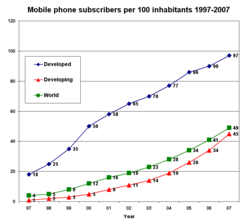Make Money Posting Ads on Cell Phones!
Are You Ready for the Mobile Marketing Era?
Click Here!
Friday, May 28, 2010
Wednesday, July 1, 2009
How To Manage a Kid’s Cell Phone Use
Teenage loves to talk on the phone. Like most kids her age there has to be some limits and rules regarding her usage. Here are 5 tips I have made to keep the cell phone bill to a minimum.
1. Set a limit on how many text messages she can make during a given week. My daughter knows she is allocated 10 text messages per week and anything above and beyond will result in loss of text messaging for the following week.
1. Set a limit on how many text messages she can make during a given week. My daughter knows she is allocated 10 text messages per week and anything above and beyond will result in loss of text messaging for the following week.
SIM card

Main article: Subscriber Identity Module
In addition to the battery, GSM mobile phones require a small microchip, called a Subscriber Identity Module or SIM Card, to function. Approximately the size of a small postage stamp, the SIM Card is usually placed underneath the battery in the rear of the unit, and (when properly activated) stores the phone's configuration data, and information about the phone itself, such as which calling plan the subscriber is using. When the subscriber removes the SIM Card, it can be re-inserted into another phone and used as normal.
Each SIM Card is activated by use of a unique numerical identifier; once activated, the identifier is locked down and the card is permanently locked in to the activating network. For this reason, most retailers refuse to accept the return of an activated SIM Card.
Those cell phones that do not use a SIM Card have the data programmed in to their memory. This data is accessed by using a special digit sequence to access the "NAM" as in "Name" or number programming menu. From here, one can add information such as a new number for your phone, new Service Provider numbers, new emergency numbers, change their Authentication Key or A-Key code, and update their Preferred Roaming List or PRL. However, to prevent someone from accidentally disabling their phone or removing it from the network, the Service Provider puts a lock on this data called a Master Subsidiary Lock or MSL.
The MSL also ensures that the Service Provider gets payment for the phone that was purchased or "leased". For example, the Motorola RAZR V9C costs upwards of CAD $500. You can get one for approximately $200, depending on the carrier. The difference is paid by the customer in the form of a monthly bill. If the carrier did not use a MSL, then they may lose the $300–$400 difference that is paid in the monthly bill, since some customers would cancel their service and take the phone to another carrier.
The MSL applies to the SIM only so once the contract has been completed the MSL still applies to the SIM. The phone however, is also initially locked by the manufacturer into the Service Providers MSL. This lock may be disabled so that the phone can use other Service Providers SIM cards. Most phones purchased outside the US are unlocked phones because there are numerous Service Providers in close proximity to one another or have overlapping coverage. The cost to unlock a phone varies but is usually very cheap and is sometimes provided by independent phone vendors.
Having an unlocked phone is extremely useful for travelers due to the high cost of using the MSL Service Providers access when outside the normal coverage areas. It can cost sometimes up to 10 times as much to use a locked phone overseas as in the normal service area, even with discounted rates. T-Mobile will provide a SIM unlock code to account holders in good standing after 90 days according to their FAQ.
For example, in Jamaica, an AT&T subscriber might pay in excess of US$1.65 per minute for discounted international service while a B-Mobile (Jamaican) customer would pay US$0.20 per minute for the same international service. Some Service Providers focus sales on international sales while others focus on regional sales. For example, the same B-Mobile customer might pay more for local calls but less for international calls than a subscriber to the Jamaican national phone C&W (Cable & Wireless) company. These rate differences are mainly due to currency variations because SIM purchases are made in the local currency. In the US, this type of service competition does not exist because some of the major Service Providers do not offer Pay-As-You-Go services. [Needs Pay-As-You-Go references, rumored T-Mobile,Verizon provide one, AT&T does not as of 12/2008]
Each SIM Card is activated by use of a unique numerical identifier; once activated, the identifier is locked down and the card is permanently locked in to the activating network. For this reason, most retailers refuse to accept the return of an activated SIM Card.
Those cell phones that do not use a SIM Card have the data programmed in to their memory. This data is accessed by using a special digit sequence to access the "NAM" as in "Name" or number programming menu. From here, one can add information such as a new number for your phone, new Service Provider numbers, new emergency numbers, change their Authentication Key or A-Key code, and update their Preferred Roaming List or PRL. However, to prevent someone from accidentally disabling their phone or removing it from the network, the Service Provider puts a lock on this data called a Master Subsidiary Lock or MSL.
The MSL also ensures that the Service Provider gets payment for the phone that was purchased or "leased". For example, the Motorola RAZR V9C costs upwards of CAD $500. You can get one for approximately $200, depending on the carrier. The difference is paid by the customer in the form of a monthly bill. If the carrier did not use a MSL, then they may lose the $300–$400 difference that is paid in the monthly bill, since some customers would cancel their service and take the phone to another carrier.
The MSL applies to the SIM only so once the contract has been completed the MSL still applies to the SIM. The phone however, is also initially locked by the manufacturer into the Service Providers MSL. This lock may be disabled so that the phone can use other Service Providers SIM cards. Most phones purchased outside the US are unlocked phones because there are numerous Service Providers in close proximity to one another or have overlapping coverage. The cost to unlock a phone varies but is usually very cheap and is sometimes provided by independent phone vendors.
Having an unlocked phone is extremely useful for travelers due to the high cost of using the MSL Service Providers access when outside the normal coverage areas. It can cost sometimes up to 10 times as much to use a locked phone overseas as in the normal service area, even with discounted rates. T-Mobile will provide a SIM unlock code to account holders in good standing after 90 days according to their FAQ.
For example, in Jamaica, an AT&T subscriber might pay in excess of US$1.65 per minute for discounted international service while a B-Mobile (Jamaican) customer would pay US$0.20 per minute for the same international service. Some Service Providers focus sales on international sales while others focus on regional sales. For example, the same B-Mobile customer might pay more for local calls but less for international calls than a subscriber to the Jamaican national phone C&W (Cable & Wireless) company. These rate differences are mainly due to currency variations because SIM purchases are made in the local currency. In the US, this type of service competition does not exist because some of the major Service Providers do not offer Pay-As-You-Go services. [Needs Pay-As-You-Go references, rumored T-Mobile,Verizon provide one, AT&T does not as of 12/2008]
Power supply

Mobile phones generally obtain power from batteries, which can be recharged from a USB port, from portable batteries, from mains power or a cigarette lighter socket in a car using an adapter (often called battery charger or wall wart) or from a solar panel or a dynamo (that can also use a USB port to plug the phone).
On 17 February 2009, the GSM Association announced[13] that they had agreed on a standard charger for mobile phones. The standard connector to be adopted by 17 manufacturers including Nokia, Motorola and Samsung is to be the micro-USB connector (several media reports erroneously reported this as the mini-USB). The new chargers will be much more efficient than existing chargers. Having a standard charger for all phones, means that manufacturers will no longer have to supply a charger with every new phone.
Formerly, the most common form of mobile phone batteries were nickel metal-hydride, as they have a low size and weight. Lithium-Ion batteries are sometimes used, as they are lighter and do not have the voltage depression that nickel metal-hydride batteries do. Many mobile phone manufacturers have now switched to using lithium-Polymer batteries as opposed to the older Lithium-Ion, the main advantages of this being even lower weight and the possibility to make the battery a shape other than strict cuboid. Mobile phone manufacturers have been experimenting with alternative power sources, including solar cells.
On 17 February 2009, the GSM Association announced[13] that they had agreed on a standard charger for mobile phones. The standard connector to be adopted by 17 manufacturers including Nokia, Motorola and Samsung is to be the micro-USB connector (several media reports erroneously reported this as the mini-USB). The new chargers will be much more efficient than existing chargers. Having a standard charger for all phones, means that manufacturers will no longer have to supply a charger with every new phone.
Formerly, the most common form of mobile phone batteries were nickel metal-hydride, as they have a low size and weight. Lithium-Ion batteries are sometimes used, as they are lighter and do not have the voltage depression that nickel metal-hydride batteries do. Many mobile phone manufacturers have now switched to using lithium-Polymer batteries as opposed to the older Lithium-Ion, the main advantages of this being even lower weight and the possibility to make the battery a shape other than strict cuboid. Mobile phone manufacturers have been experimenting with alternative power sources, including solar cells.
Applications

The most commonly used data application on mobile phones is SMS text messaging, with 74% of all mobile phone users as active users (over 2.4 billion out of 3.3 billion total subscribers at the end of 2007). SMS text messaging was worth over 100 billion dollars in annual revenues in 2007 and the worldwide average of messaging use is 2.6 SMS sent per day per person across the whole mobile phone subscriber base. (source Informa 2007). The first SMS text message was sent from a computer to a mobile phone in 1992 in the UK, while the first person-to-person SMS from phone to phone was sent in Finland in 1993.
The other non-SMS data services used by mobile phones were worth 31 Billion dollars in 2007, and were led by mobile music, downloadable logos and pictures, gaming, gambling, adult entertainment and advertising (source: Informa 2007). The first downloadable mobile content was sold to a mobile phone in Finland in 1998, when Radiolinja (now Elisa) introduced the downloadable ringing tone service. In 1999 Japanese mobile operator NTT DoCoMo introduced its mobile internet service, i-Mode, which today is the world's largest mobile internet service and roughly the same size as Google in annual revenues.

The first mobile news service, delivered via SMS, was launched in Finland in 2000. Mobile news services are expanding with many organisations providing "on-demand" news services by SMS. Some also provide "instant" news pushed out by SMS. Mobile telephony also facilitates activism and public journalism being explored by Reuters and Yahoo![12] and small independent news companies such as Jasmine News in Sri Lanka.
Companies like Monster.com are starting to offer mobile services such as job search and career advice. Consumer applications are on the rise and include everything from information guides on local activities and events to mobile coupons and discount offers one can use to save money on purchases. Even tools for creating websites for mobile phones are increasingly becoming available.
Mobile payments were first trialled in Finland in 1998 when two Coca-Cola vending machines in Espoo were enabled to work with SMS payments. Eventually the idea spread and in 1999 the Philippines launched the first commercial mobile payments systems, on the mobile operators Globe and Smart. Today mobile payments ranging from mobile banking to mobile credit cards to mobile commerce are very widely used in Asia and Africa, and in selected European markets. For example in the Philippines it is not unusual to have one's entire paycheck paid to the mobile account. In Kenya the limit of money transfers from one mobile banking account to another is one million US dollars. In India paying utility bills with mobile gains a 5% discount. In Estonia the government found criminals collecting cash parking fees, so the government declared that only mobile payments via SMS were valid for parking and today all parking fees in Estonia are handled via mobile and the crime involved in the activity has vanished.
Mobile Applications are developed using the Six M's (previously Five M's) service-development theory created by the author Tomi Ahonen with Joe Barrett of Nokia and Paul Golding of Motorola. The Six M's are Movement (location), Moment (time), Me (personalization), Multi-user (community), Money (payments) and Machines (automation). The Six M's / Five M's theory is widely referenced in the telecoms applications literature and used by most major industry players. The first book to discuss the theory was Services for UMTS by Ahonen & Barrett in 2002.
The other non-SMS data services used by mobile phones were worth 31 Billion dollars in 2007, and were led by mobile music, downloadable logos and pictures, gaming, gambling, adult entertainment and advertising (source: Informa 2007). The first downloadable mobile content was sold to a mobile phone in Finland in 1998, when Radiolinja (now Elisa) introduced the downloadable ringing tone service. In 1999 Japanese mobile operator NTT DoCoMo introduced its mobile internet service, i-Mode, which today is the world's largest mobile internet service and roughly the same size as Google in annual revenues.

The first mobile news service, delivered via SMS, was launched in Finland in 2000. Mobile news services are expanding with many organisations providing "on-demand" news services by SMS. Some also provide "instant" news pushed out by SMS. Mobile telephony also facilitates activism and public journalism being explored by Reuters and Yahoo![12] and small independent news companies such as Jasmine News in Sri Lanka.
Companies like Monster.com are starting to offer mobile services such as job search and career advice. Consumer applications are on the rise and include everything from information guides on local activities and events to mobile coupons and discount offers one can use to save money on purchases. Even tools for creating websites for mobile phones are increasingly becoming available.
Mobile payments were first trialled in Finland in 1998 when two Coca-Cola vending machines in Espoo were enabled to work with SMS payments. Eventually the idea spread and in 1999 the Philippines launched the first commercial mobile payments systems, on the mobile operators Globe and Smart. Today mobile payments ranging from mobile banking to mobile credit cards to mobile commerce are very widely used in Asia and Africa, and in selected European markets. For example in the Philippines it is not unusual to have one's entire paycheck paid to the mobile account. In Kenya the limit of money transfers from one mobile banking account to another is one million US dollars. In India paying utility bills with mobile gains a 5% discount. In Estonia the government found criminals collecting cash parking fees, so the government declared that only mobile payments via SMS were valid for parking and today all parking fees in Estonia are handled via mobile and the crime involved in the activity has vanished.
Mobile Applications are developed using the Six M's (previously Five M's) service-development theory created by the author Tomi Ahonen with Joe Barrett of Nokia and Paul Golding of Motorola. The Six M's are Movement (location), Moment (time), Me (personalization), Multi-user (community), Money (payments) and Machines (automation). The Six M's / Five M's theory is widely referenced in the telecoms applications literature and used by most major industry players. The first book to discuss the theory was Services for UMTS by Ahonen & Barrett in 2002.
Subscribe to:
Posts (Atom)





